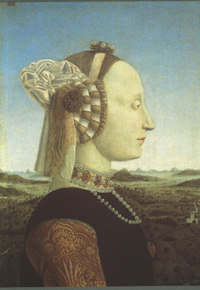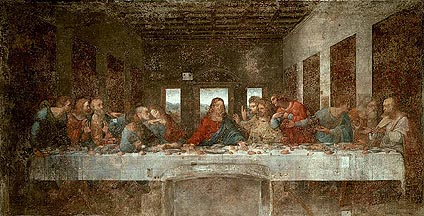Web Link
If you are interested in exploring the Mona Lisa and Leonardo's attitudes about art and nature, you can read the excerpts I have compiled of Mary Garrard's article entitled "Leonardo da Vinci: Female Portraits, Female Nature."
See also the webpage entitled the Art and Science of Leonardo da Vinci.

|

|
| Leonardo, Mona Lisa, 1503-5 | Piero della Francesca, Battista Sforza |
Compare these two artists' attitudes towards portraiture in relationship to the following quotation from Leonardo's notebooks: "A good painter has two chief objects to paint, man and the intention of his soul; the former is easy, the latter hard, because he has to represent it by the attitudes and movements of the limbs."

|

|
| Leonardo, Last Supper, 1495-97/98. | Castagno, Last Supper, c. 1445-50. |
Compare and contrast the styles of these two works. Define what Leonardo has drawn from his artistic inheritance and also what innovations he has introduced.
QUOTATIONS FROM THE NOTEBOOKS OF LEONARDO DA VINCI
Though I have no power to quote from authors as they have, I shall rely on a far bigger and more worthy thing--on experience, the instructress of their masters. They strut about puffed up and pompous, decked out and adorned not with their own labours, but by those of others, and they will not even allow me my own. And if they despise me who am an inventor, how much more should they be blamed who are not inventors but trumpeters and reciters of the works of others.
Wisdom is the daughter of experience.
First I shall test by experiment before I proceed farther, because my intention is to consult experience first and then with reasoning show why such experience is bound to operate in such a way. And this is the true rule by which those who analyze the effects of nature must proceed; and although nature begins with the cause and ends with experience, we must follow the opposite course namely, begin with experience, and by means of it investigate the cause.
Man has been called by the ancients a lesser world and indeed the term is well applied. Seeing that if a man is composed of earth, water, fire, and air, this body of earth is similar. While man has within himself bones as a stay and framework for the flesh, the world has stones which are the supports of earth. While man has within him a pool of blood wherein the lungs as he breathes expand and contract, so the body of the earth has its ocean, which also rises and falls every six hours with the breathing of the world; as from the said pool of blood proceed the veins which spread their branches through the human body so the ocean fills the body of the earth with an infinite number of veins of water.... The cause which moves the water through its springs against the natural course of its gravity is like that which moves the humours in all the shapes of animated bodies.
A good painter has two chief objects to paint, man and the intention of his soul; the former is easy, the latter hard, because he has to represent it by the attitudes and movements of the limbs.... The most important consideration in painting is that the movements of each figure expresses its mental state, such as desire, scorn, anger, pity, and the like.
Note the motion of the surface of the water which conforms to that of the hair, which has two motions, of which one responds to the weight of the strands and the other to the direction of the curls....
Thus, without rest it [water] is ever removing and consuming her borders. So at times it is turbulent and goes raving in fury, at times clear and tranquil it flows playfully with gentle course among fresh meadows. At time it falls from the sky in rain or snow or hail, at times forms great clouds of fine mist.
Oh Time, who consumes all things! Oh envious age, you who destroy all things and devour all things with the hard teeth of the years, little by little, in slow death! Helen, when she looked in her mirror, seeing the withered wrinkles in her face made by old age, wept, and thought to herself, why ever had she been twice ravished. Oh Time, who consumes all things! Oh envious age, by whom all things are consumed!
The deity which invests the science of the painter functions in such a way that the mind of the painter is transformed into a copy of the divine mind, since it operates freely in creating the many kinds of animals, plants, fruits, landscapes, countrysides, ruins, and awe-inspiring places.
The mind of the painter must resemble a mirror, which always takes the color
of the object it reflects and is completely occupied by the images of as many
objects as are in front of it. Therefore you must know, O painter! that you
cannot be a good one if you are not the universal master of representing by
your art every kind of form produced by nature. And this you will not know how
to do if you do not see them, and retain them in your mind. Hence as you go
through the fields, turn your attention to various objects, and in turn look
now at this thing and now at that, collecting a store of diverse facts selected
and chosen from those of less value.
If the painter wishes to see beauties that charm him, it lies in his power to create them, and if he wishes to see monstrosities that are frightful, ridiculous, or truly pitiable, he is lord and God thereof; and if he wishes to generate sites and deserts, shady and cool places in hot weather he can do so, and also warm places in cold weather. If he wishes from the high summits of the mountains to uncover the great countrysides, and if he wishes after them to see the horizon of the sea, he is lord of it, and if from the low valleys he wishes to see the high mountains, or from the high mountains the low valleys and beaches, and in effect that which is in the universe for essence, presence, or imagination, he has it first in his mind and then in his hands, and these are of such excellence that in equal time they generate a proportionate harmony in a single glance, as does nature.
The painter in his harmonious proportions makes the component parts react simultaneously so that they can be seen at one and the same time both together and separately; together, by viewing the design of the composition as a whole; and separately by viewing the design of its component parts.